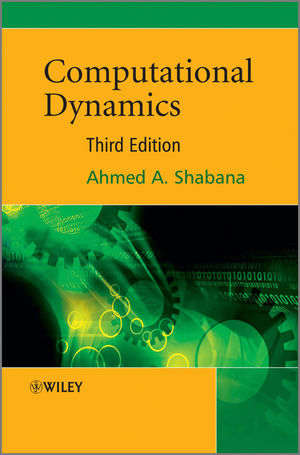Computational Dynamics, 3rd EditionISBN: 978-0-470-68615-7
Hardcover
584 pages
March 2010
 This is a Print-on-Demand title. It will be printed specifically to fill your order. Please allow an additional 10-15 days delivery time. The book is not returnable.
|
||||||
1 Introduction.
1.1 Computational Dynamics.
1.2 Motion and Constraints.
1.3 Degrees of Freedom.
1.4 Kinematic Analysis.
1.5 Force Analysis.
1.6 Dynamic Equations and Their Different Forms.
1.7 Forward and Inverse Dynamics.
1.8 Planar and Spatial Dynamics.
1.9 Computer and Numerical Methods.
1.10 Organization, Scope, and Notations of the Book.
2 Linear Algebra.
2.1 Matrices.
2.2 Matrix Operations.
2.3 Vectors.
2.4 Three-Dimensional Vectors.
2.5 Solution of Algebraic Equations.
2.6 Triangular Factorization.
2.7 QR Decomposition.
2.8 Singular Value Decomposition.
Problems.
3 Kinematics.
3.1 Kinematics of Rigid Bodies.
3.2 Velocity Equations.
3.3 Acceleration Equations.
3.4 Kinematics of a Point Moving on a Rigid Body.
3.5 Constrained Kinematics.
3.6 Classical Kinematic Approach.
3.7 Computational Kinematic Approach.
3.8 Formulation of the Driving Constraints.
3.9 Formulation of the Joint Constraints.
3.10 Computational Methods in Kinematics.
3.11 Computer Implementation.
3.12 Kinematic Modeling and Analysis.
3.13 Concluding Remarks.
Problems.
4 Forms of the Dynamic Equations.
4.1 D’Alembert’s Principle.
4.2 D’Alembert’s Principle and Newton–Euler Equations.
4.3 Constrained Dynamics.
4.4 Augmented Formulation.
4.5 Lagrange Multipliers.
4.6 Elimination of the Dependent Accelerations.
4.7 Embedding Technique.
4.8 Amalgamated Formulation.
4.9 Open-Chain Systems.
4.10 Closed-Chain Systems.
4.11 Concluding Remarks.
Problems.
5 Virtual Work and Lagrangian Dynamics.
5.1 Virtual Displacements.
5.2 Kinematic Constraints and Coordinate Partitioning.
5.3 Virtual Work.
5.4 Examples of Force Elements.
5.5 Workless Constraints.
5.6 Principle of Virtual Work in Statics.
5.7 Principle of Virtual Work in Dynamics.
5.8 Lagrange’s Equation.
5.9 Gibbs–Appel Equation.
5.10 Hamiltonian Formulation.
5.11 Relationship between Virtual Work and Gaussian Elimination.
Problems.
6 Constrained Dynamics.
6.1 Generalized Inertia.
6.2 Mass Matrix and Centrifugal Forces.
6.3 Equations of Motion.
6.4 System of Rigid Bodies.
6.5 Elimination of the Constraint Forces.
6.6 Lagrange Multipliers.
6.7 Constrained Dynamic Equations.
6.8 Joint Reaction Forces.
6.9 Elimination of Lagrange Multipliers.
6.10 State Space Representation.
6.11 Numerical Integration.
6.12 Algorithm and Sparse Matrix Implementation.
6.13 Differential and Algebraic Equations.
6.14 Inverse Dynamics.
6.15 Static Analysis.
Problems.
7 Spatial Dynamics.
7.1 General Displacement.
7.2 Finite Rotations.
7.3 Euler Angles.
7.4 Velocity and Acceleration.
7.5 Generalized Coordinates.
7.6 Generalized Inertia Forces.
7.7 Generalized Applied Forces.
7.8 Dynamic Equations of Motion.
7.9 Constrained Dynamics.
7.10 Formulation of the Joint Constraints.
7.11 Newton–Euler Equations.
7.12 D’Alembert’s Principle.
7.13 Linear and Angular Momentum.
7.14 Recursive Methods.
Problems.
8 Special Topics in Dynamics.
8.1 Gyroscopes and Euler Angles.
8.2 Rodriguez Formula.
8.3 Euler Parameters.
8.4 Rodriguez Parameters.
8.5 Quaternions.
8.6 Rigid Body Contact.
8.7 Stability and Eigenvalue Analysis.
Problems.
9 Multibody Sysyem Computer Codes.
9.1 Introduction to SAMS/2000.
9.2 Code Structure.
9.3 System Identification and Data Structure.
9.4 Installing the Code and Theoretical Background.
9.5 SAMS/2000 Setup.
9.6 Use of the Code.
9.7 Body Data.
9.8 Constraint Data.
9.9 Performing Simulations.
9.10 Batch Jobs.
9.11 Graphics Control.
9.12 Animation Capabilities.
9.13 General Use of the Input Data Panels.
9.14 Spatial Analysis.
9.15 Special Modules and Features of the Code.
References.
Index.



